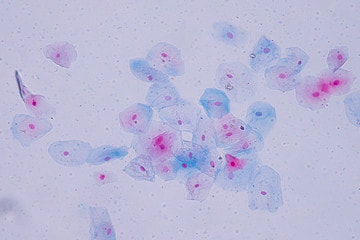Immunohistochemistry & Competitive Inhibition
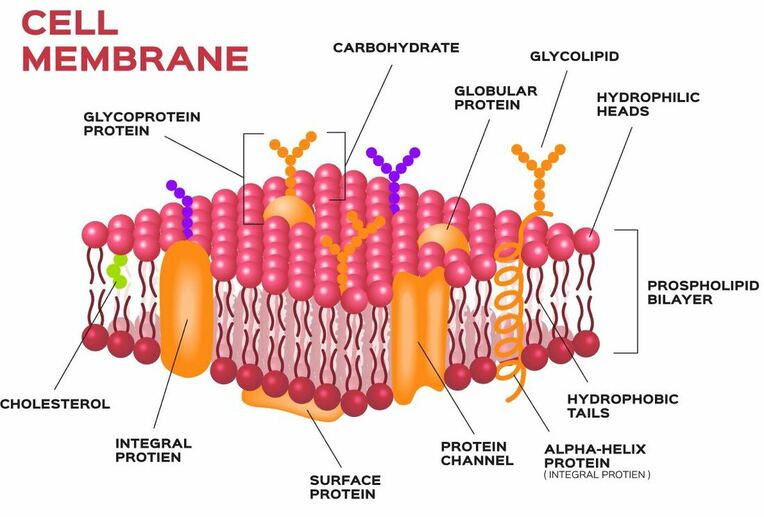
The plasma membrane of a cell is composed of a lipid bilayer, proteins and carbohydrates. Plasma membrane proteins can be embedded across the membrane (transmembrane proteins) or anchored to the membrane on the extracellular or intracellular surface (peripheral proteins). Transmembrane proteins are often bound to oligosaccharide chains (sugar chains) on the extracellular side of the plasma membrane (glycoproteins). Many of these glycoproteins are used as means for cell communication/recognition and are referred to as cell-surface receptors.
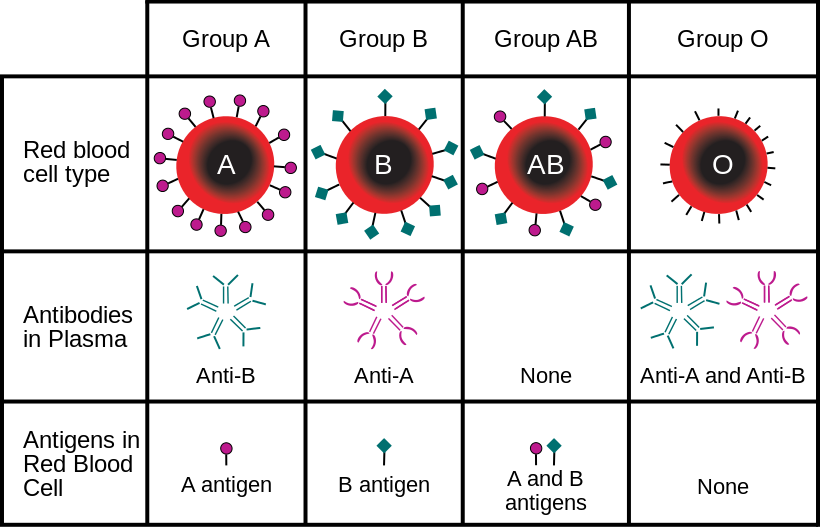
A good example of how we can use antibodies to identify membrane proteins or carbohydrates (antigens) when we test a person for their blood type.
The red blood cells (RBCs/erythrocytes) can contain the glycoproteins A and/or B or neither that make up the A, B, O system used to determine blood type.
The red blood cells (RBCs/erythrocytes) can contain the glycoproteins A and/or B or neither that make up the A, B, O system used to determine blood type.
- An antigen is defined as ANYTHING that an ANTIBODY will bind to. When an antibody binds to its antigen, the cells clump together (agglutinate).
- If agglutination occurs with antibodies against glycoprotein A BUT NOT with antibodies against glycoprotein B, then the blood type is type A.
- If agglutination occurs with antibodies against glycoprotein B BUT NOT with antibodies against glycoprotein A, then the blood type is type B.
- If agglutination occurs with BOTH glycoprotein A and B (type AB blood) then the blood type is type AB.
- If agglutination DOES NOT occur with EITHER glycoprotein A or B then the blood type is type O.
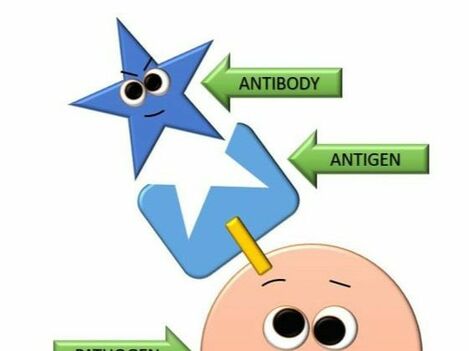
The agglutination (clumping) process is helped by lectins. Concanavalin A (ConA) is a lectin (carbohydrate-binding protein) Lectins are proteins that bind to the oligosaccharide chains on glycoproteins on the plasma membrane of RBCs.
Immunohistochemistry is a technique that physiologists can use to determine if certain molecules are present in the sample.
Antibodies are made that will bind to certain amino acid sequences. Glycolipids and glycoproteins have specific carbohydrate chains that help create receptors. Immunohistochemistry allows us to use lectins (a protein molecule that will bind to specific carbohydrates and tends to be isolated from plants) to determine the carbohydrate make-up of the cell surface receptors of a cell.
Immunohistochemistry is a technique that physiologists can use to determine if certain molecules are present in the sample.
Antibodies are made that will bind to certain amino acid sequences. Glycolipids and glycoproteins have specific carbohydrate chains that help create receptors. Immunohistochemistry allows us to use lectins (a protein molecule that will bind to specific carbohydrates and tends to be isolated from plants) to determine the carbohydrate make-up of the cell surface receptors of a cell.
LECTIN
- The agglutination (clumping) process is helped by lectins. Concanavalin A (ConA) is a lectin (carbohydrate-binding protein)
- Lectins are proteins that bind to the oligosaccharide chains on glycoproteins on the plasma membrane of RBCs.
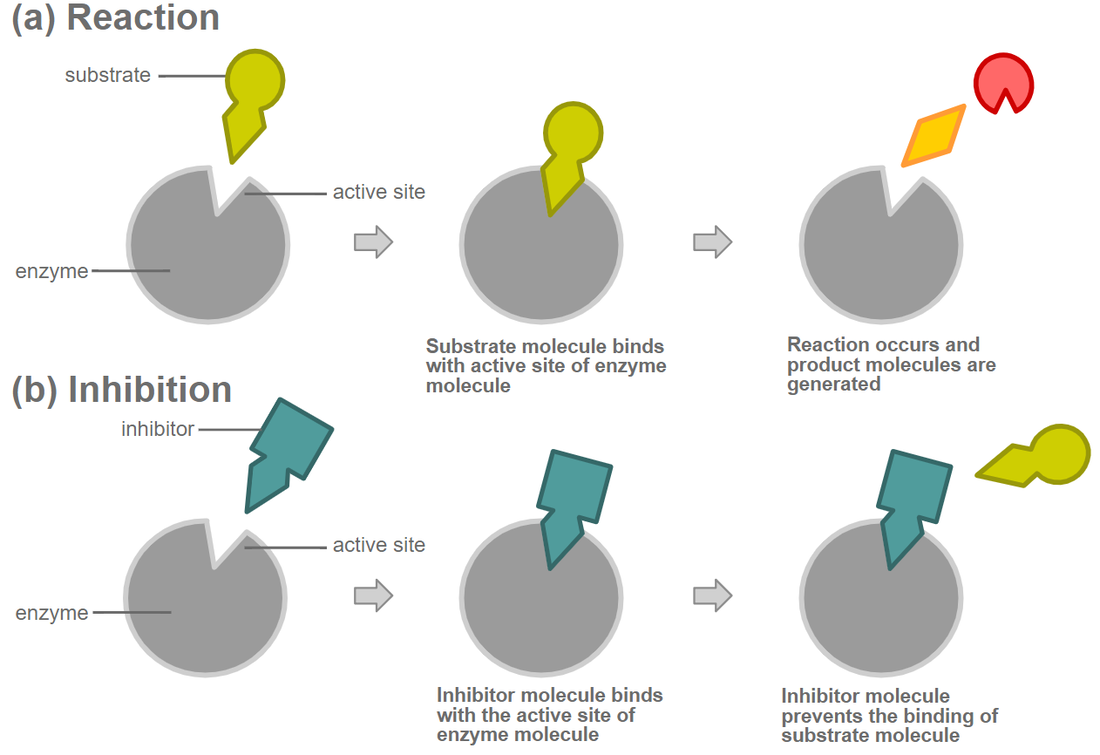
In this lab you will determine if cheek epithelial cells express cell surface receptors that bind Concanavalin A (Con A). By adding various free carbohydrates (monosaccharides), we can determine if these free carbohydrates compete with the receptors on the cell surface.
If the free carbohydrates are competitive inhibitors, then lectin (Con A) will bind to both the free carbohydrate and the receptor and we can conclude that the cell surface receptor contains the same structure as the free carbohydrate. If the free carbohydrates are not competitive inhibitors, then the lectin will only bind to the cell surface receptor and we can conclude that the receptor does not contain the same structure as the free carbohydrate. You will use two ways to visualize the lectin (Con A) binding to the cell surface receptors: 1) colorimetric (color change) and 2) hemagglutination (seeing red blood cells clump/stick together). Your objective is to identify the type of sugar chains found on Con A cell surface receptors that allow Con A (lectin) to bind.
If the free carbohydrates are competitive inhibitors, then lectin (Con A) will bind to both the free carbohydrate and the receptor and we can conclude that the cell surface receptor contains the same structure as the free carbohydrate. If the free carbohydrates are not competitive inhibitors, then the lectin will only bind to the cell surface receptor and we can conclude that the receptor does not contain the same structure as the free carbohydrate. You will use two ways to visualize the lectin (Con A) binding to the cell surface receptors: 1) colorimetric (color change) and 2) hemagglutination (seeing red blood cells clump/stick together). Your objective is to identify the type of sugar chains found on Con A cell surface receptors that allow Con A (lectin) to bind.
 The Chemical Structure of Mannose
The Chemical Structure of Mannose
Lectins are carbohydrate-binding proteins, macromolecules that are highly specific for sugar moieties of other molecules. They are also known as phytohemagglutinins. Lectins perform recognition on the cellular and molecular level and play .... Lectins are similar to antibodies in their ability to agglutinate red blood cells.
A type of Lectin called concanavalin A, have been used widely as model systems to understand the molecular basis of how proteins recognize carbohydrates, because they are relatively easy to obtain and have a wide variety of sugar specificities. The many crystal structures of legume lectins have led to a detailed insight of the atomic interactions between carbohydrates and proteins.
Concanavalin A (Con A) is a plant lectin that is purified from jack beans.
A type of Lectin called concanavalin A, have been used widely as model systems to understand the molecular basis of how proteins recognize carbohydrates, because they are relatively easy to obtain and have a wide variety of sugar specificities. The many crystal structures of legume lectins have led to a detailed insight of the atomic interactions between carbohydrates and proteins.
Concanavalin A (Con A) is a plant lectin that is purified from jack beans.
- Con A binds to the mannose residues of various glycoproteins
- Con A DOES NOT bind to galactose residues of various glycoproteins
Lab exercises:
|
LAB A. Antigen-Antibody interaction simulation
Equipment:
Protocol:
B. Immunohistochemistry-Cheek Cells Equipment
Protocol:
C. Immunohistochemistry-Red Blood Cells Equipment
Protocol
|
|
Immunohistochemistry Post-Lab Assignment: A. Immunohistochemistry-Demo using models
● Draw three examples for the cheek cell demo. Label the cell, antibody, and antigen. Determine if there is specificity and/or competitive inhibition. Determine if the cells will bind the antigen/lectin and result in the cells turning purple.
● Draw three examples for the cheek cell demo. Label the cell, antibody, and antigen. Determine if there is specificity and/or competitive inhibition. Determine if the cells will bind the antigen/lectin and result in the cells turning purple.
Draw three examples for the red blood cell demo. Label the cell, antibody, and antigen. Determine if there is specificity and/or competitive inhibition. Determine if the cells will bind the antigen/lectin and result in hemagglutination.
Immunohistochemistry-Cheek Cells
● Draw your results for Slide #1.
o What color were the cells? ____________________________ o
Did competitive inhibition occur? ________________________
Draw your results for Slide #2.
o What color were the cells? ____________________________ o
Did competitive inhibition occur? ________________________
● Draw your results for Slide #3.
o What color were the cells? ____________________________ o
Did competitive inhibition occur? ________________________
● Draw your results for Slide #4.
What color were the cells? ____________________________ o
Did competitive inhibition occur? ________________________
● Explain the mechanism behind the purple color reaction.
● Which sugar inhibited Con A binding to cheek epithelial cells? _____________
● Draw your results for Slide #1.
o What color were the cells? ____________________________ o
Did competitive inhibition occur? ________________________
Draw your results for Slide #2.
o What color were the cells? ____________________________ o
Did competitive inhibition occur? ________________________
● Draw your results for Slide #3.
o What color were the cells? ____________________________ o
Did competitive inhibition occur? ________________________
● Draw your results for Slide #4.
What color were the cells? ____________________________ o
Did competitive inhibition occur? ________________________
● Explain the mechanism behind the purple color reaction.
● Which sugar inhibited Con A binding to cheek epithelial cells? _____________
Immunohistochemistry-Red Blood Cells ● Draw your results for Slide #1.
o Did hemagglutination occur? __________________________ o Did competitive inhibition occur? ________________________
● Draw your results for Slide #2.
o Did hemagglutination occur? __________________________ o Did competitive inhibition occur? ________________________
111
● Draw your results for Slide #3.
o Did hemagglutination occur? __________________________ o Did competitive inhibition occur? ________________________
● Draw your results for Slide #4.
o Did hemagglutination occur? __________________________ o Did competitive inhibition occur? ________________________
● Which sugar inhibited Con A from agglutinating red blood cells? __________
o Did hemagglutination occur? __________________________ o Did competitive inhibition occur? ________________________
● Draw your results for Slide #2.
o Did hemagglutination occur? __________________________ o Did competitive inhibition occur? ________________________
111
● Draw your results for Slide #3.
o Did hemagglutination occur? __________________________ o Did competitive inhibition occur? ________________________
● Draw your results for Slide #4.
o Did hemagglutination occur? __________________________ o Did competitive inhibition occur? ________________________
● Which sugar inhibited Con A from agglutinating red blood cells? __________

